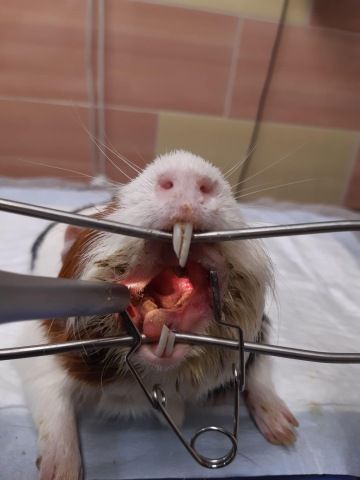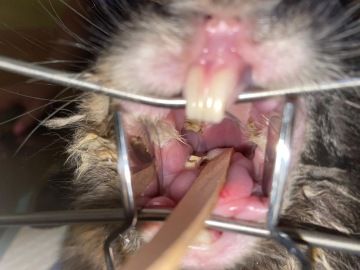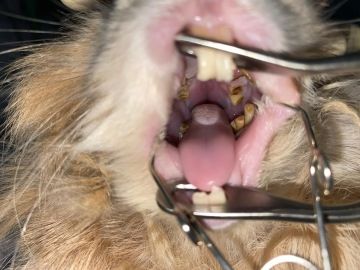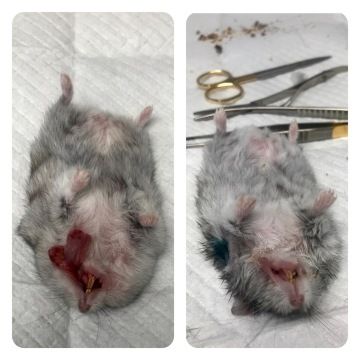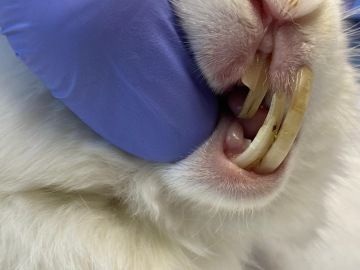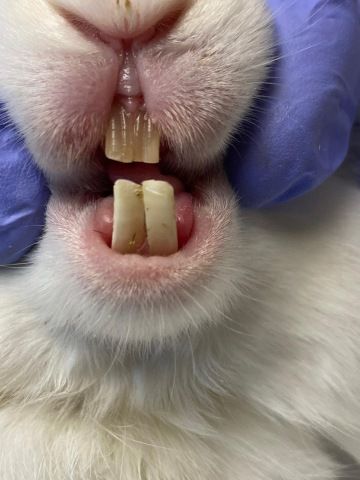Stomatology of rodents
Rabbit teeth are part of a complex digestive system that supports the efficient processing of plant materials that are indigestible to many other species. The front teeth (referred to as incisors) contain four sharp, chisel-shaped incisors, two at the top and two at the bottom. Behind the upper front incisors are two smaller incisors. In correct occlusion, the lower incisors rest behind the upper incisors. Furthermore, rabbits have twenty-two premolars and molars, also called molars. Their deep grooves create ridges that are ideal for breaking down fibrous plant materials. In a healthy rabbit, molars come into contact only during the chewing process.
Rabbits use their incisors to cut food and the tongue moves the food into the mouth. The stools subsequently crush the food on one or the other side of the jaw. One of the most important features of teeth is that they grow continuously throughout a rabbit's life. Teeth in healthy rabbits are properly worn down by ingestion of coarse plant materials. It is important that rabbit teeth maintain the correct length, shape and alignment. When tooth grinding is reduced or abnormal, the risk of dental problems increases.
What are the most common causes of dental disease in rabbits?
Congenital (hereditary) causes
Traumatic injury
A change in the shape of the jaw
Primary malocclusion of teeth
Metabolic bone disease
All but genetic disorders are commonly referred to as acquired dental disease. Dental problems can be very serious and can lead to health problems. For example, overgrowth of molars can lead to obstruction of the nasal passages, or overgrowth of roots can cause obstruction of the nasolacrimal duct.
What are the symptoms when a rabbit has a dental problem?
Although dental problems are common, rabbits often mask the condition. It is therefore advisable to keep in mind some of the symptoms that may occur:
Picky eating or a sudden change in food preferences
Falling food with mouths
Dribbling
Wet fur on face and front legs
Decreased intake of food and drink with a corresponding change in stool volume
Weight change
Halitosis
Decreased activity
Reduced grooming
Poor coat condition and shedding
Accumulation of caecotrophs around the anus (soft mucus-coated snots that rabbits normally eat directly from the anus, mostly at night)
Discharge from the eyes
Soreness (e.g. hunched posture, teeth grinding)
Lethargy
Anorexia/weight loss
Swelling of the face
It is important to remember that the clinical symptoms of dental disease are non-specific – they may indicate some other health problem. In addition, symptoms can sometimes be caused by something other than a medical condition. For example, pickiness in food can be related to its quality or to a change in the menu. Reduced activity may be a response to unfamiliar visitors. Anything that stresses a rabbit can change behavior. Observing the variables that affect your rabbit makes it easier to spot problems before they become serious.
The most common dental problems
Rabbit dentistry is complex, mainly because the teeth grow continuously. In addition, the oral cavity is small, with cheek folds. Dental disorders can generally be successfully treated when the problem is identified at an early stage. Diagnosis and treatment is carried out with specialized dental examination tools (spreaders, mirrors, grinding wheels and drills), taking X-ray images of the skull to determine the position of the teeth and in some cases also endoscopic examination of the oral cavity. Sedation is required for a thorough stool examination.
Abscesses
Abscesses of the face are most often associated with dental disease. they mostly arise as a result of overgrown teeth or after a tooth fracture. It is a serious and often difficult to treat disease, requiring surgical treatment not only of the abscess itself but also of the teeth, often associated with the extraction of the affected teeth.
Fractures
Fractures are serious injuries that can lead to other problems, including damage to the apexes (tips of tooth roots) and subsequent abnormal tooth growth. Tooth fractures can also cause abscesses to form. The incisors can break from a fall or when a rabbit suffers some other head injury. When teeth are overgrown, they are also more prone to fracture. In addition, improper dental treatment can cause a tooth to break. Simply cutting overgrown teeth with nail clippers or regular scissors carries the risk of tooth fracture and abscess formation.
"Hooks"
When molars don't wear evenly, they form sharp protrusions called hooks that can injure a rabbit's tongue, cheeks, and other soft oral tissue. Although it may seem that a small sharp point on the tooth will not cause serious problems, the opposite is true. When the rabbit tries to avoid using a particular tooth, abnormal pressure is exerted on the other teeth and the uneven wear is even greater, which subsequently leads to the deepening of the problem and the appearance of malocclusion, ingrowth of stool roots... In addition, an abscess may form in the soft tissue. A rabbit's teeth are constantly growing, so the abnormal pressure of misaligned teeth on other teeth is a cause of discomfort. What may seem like a small problem has the potential to negatively affect the entire mouth (eg other teeth, muscles, ligaments).
Malocclusion
Incorrect positioning of the teeth, i.e. malocclusion, can be divided into:
malocclusion of incisors
malocclusion of molars
Malocclusion of the incisors is a noticeable problem that the owner notices quite quickly. In rabbits with congenital malformation of the jaw and incorrect position of the incisors without molar disease, frequent trimming of the incisors is often necessary, every four to six weeks for the entire life of the animal. In such a case, extraction of the incisors is the best option. Other reasons for incisor extraction include fracture, endodontic disease, and facial abscess. It is important that the entire tooth (including the pulp tissue) is removed, but even here there is a small chance that the teeth will grow back. Rabbits do not require incisors to consume hay and pellets and usually do very well after extraction. Keep in mind that overgrowth of incisors affects the proper function of the jaw, thereby affecting the health of the stools (and vice versa). If your rabbit has problems with its incisors, it is important to have its molars checked regularly.
Molar malocclusion is generally not noticed by the owner as often as malocclusion of incisors. there are two main causes of acquired molar malocclusion:
inappropriate wear and tear from improper diet
metabolic bone disease
With irregular growth, all molars are affected. Abnormal wear and growth inevitably occurs, affecting the entire mouth, including the musculature. The normal functioning of the rabbit jaw requires all teeth to be properly shaped and aligned. Serious dental disease from any cause can lead to the most serious complication - dental abscesses and subsequent bone infection (osteomyelitis). Unless the molar is loose or infected, extraction is not recommended due to the arrangement and function of rabbit teeth. If an abscess develops, extraction of the affected tooth and the entire pocket of pus (as a solid mass) is key to success in treatment. Surgery can result in extensive bone loss, as the affected bone and surrounding tissue must be removed to prevent the spread of bacteria. It is likely that the rabbit will require both systemic and topical medication and a series of several sessions and examinations along with x-rays.
Is there a prevention of dental diseases in rabbits?
Unfortunately, it is not clear what causes acquired dental disease in all rabbits, but diet is believed to be an important factor. Basically, when the diet lacks enough fiber, the teeth grow faster than they wear down, resulting in uneven and unusual tooth length, malocclusion, food trapping, abnormal curvature, hook formation, loose molars... . The diet of wild European rabbits (from which our domestic rabbits originate) consists mainly of plants rich in fiber and silicates. The closest thing to that is grass hay. The need for hay in a rabbit's diet is not only for healthy teeth, but also for the proper functioning of the digestive system. Some hays may lack vitamins and minerals, therefore it is necessary to always choose high-quality grass hay. This problem can be solved by feeding grass pellets made on the basis of high quality grass hay (not containing soy, dried beans, grains, seeds or pieces of fruit). Pellets should be given as a dietary supplement to grass hay and not, as is customary, to feed the rabbit only with pellets. Pellets have a higher caloric density, which means that rabbits eating only pellets are quickly satiated and the pellets are too small and soft to properly wear down the teeth. In addition to requiring less chewing time, pellets cause the rabbit to chew in an up-and-down motion rather than a natural side-to-side motion that keeps the teeth ground. It is important to remember that the pellets were developed for rabbits in production (breeding and meat industries) to minimize mess and to optimize rapid muscle and fur growth. Green leafy vegetables are also important for a rabbit's diet because they are rich in vitamins; however, it should be fed in measured amounts so that the rabbit also consumes hay. In conclusion, it is important to remember that a rabbit's diet should be 90% grass hay.
